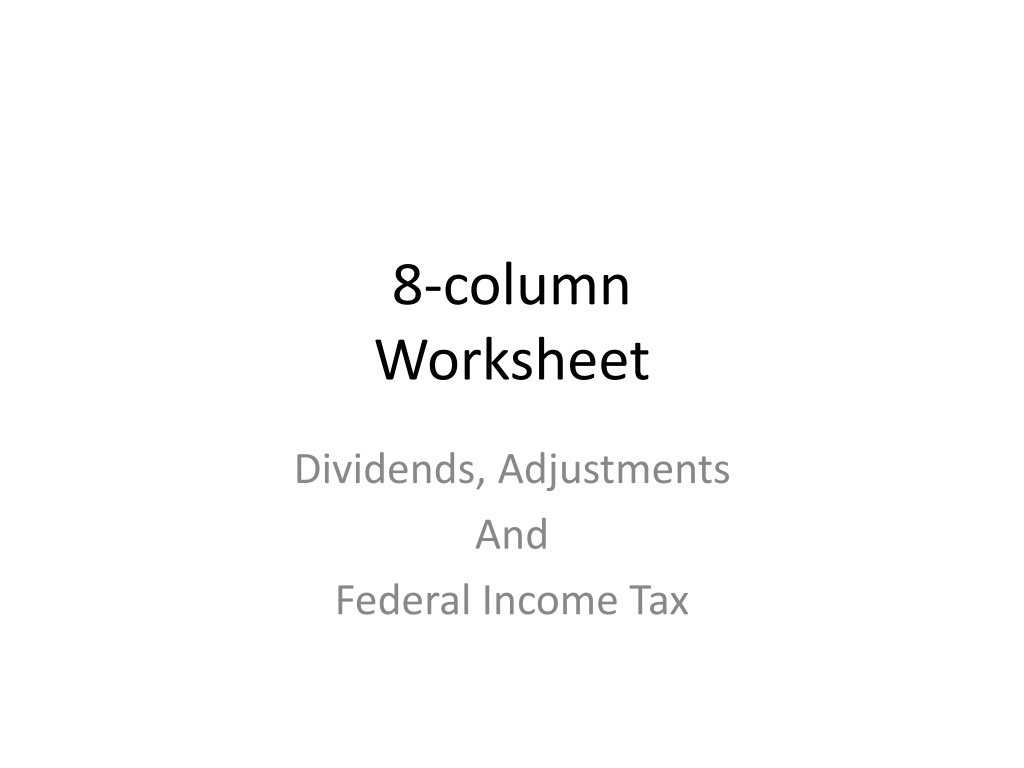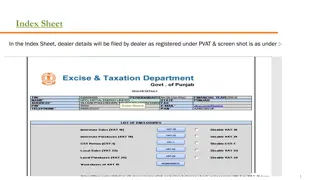Dividends, Adjustments, and Federal Income Tax Worksheet
This worksheet helps in organizing information related to dividends, adjustments, and federal income tax in a clear and structured manner. It is designed to assist in calculations and documentation for tax purposes. By using the 8-column format, users can efficiently track and record the necessary details for accurate reporting and analysis. This tool aids in managing financial data effectively, ensuring compliance with tax regulations, and optimizing tax preparation processes.
Download Presentation

Please find below an Image/Link to download the presentation.
The content on the website is provided AS IS for your information and personal use only. It may not be sold, licensed, or shared on other websites without obtaining consent from the author.If you encounter any issues during the download, it is possible that the publisher has removed the file from their server.
You are allowed to download the files provided on this website for personal or commercial use, subject to the condition that they are used lawfully. All files are the property of their respective owners.
The content on the website is provided AS IS for your information and personal use only. It may not be sold, licensed, or shared on other websites without obtaining consent from the author.
E N D
Presentation Transcript
8-column Worksheet Dividends, Adjustments And Federal Income Tax
Dividends When declared Multiply the dividend per share by the number of issued shares Record in the General Journal: Dividends Dividends Payable When issued Record in the Cash Payments Journal: Dividends Payable Cash (in special Cash Credit column) Debit Credit Debit Credit
Trial Balance 1. Write the title of every general ledger account, even if there is currently no balance 2. Write the balances of each account on the Trial Balance (from the general ledger), make sure you put in the correct column Debit/Credit 3. Total, prove and rule the Debit and Credit columns
Adjustment for Supplies Ask 4 questions 1. What is the balance of the Supplies account? 2. What should the balance be for this account? 3. What must be done to correct the account balance? Add/subtract? 4. What adjustment is made?
Adjustment for Supplies Beginning balance for Supplies Ending balance for Supplies Difference/adjustment $3,000 $1,000 $2,000 Adjustment entry on the Worksheet: Expense account for Supplies Debit Asset account Supplies Credit
Adjustment for Prepaid Insurance Value of the insurance on January 1 Less the value of the insurance on Dec 31 Equals the amount used up during the year Ask the same 4 questions as you did with supplies Record in the Adjustment Column of the Worksheet: Insurance Expense Prepaid Insurance Debit Credit
Adjustment for Merchandise Inventory Again, ask the same 4 questions Beginning Inventory Less Ending Inventory Equals amount of adjustment Record in the Adjustment Column of the Worksheet (if the inventory is less at the end of the year): Income Summary Merchandise Inventory Debit Credit
Adjustment for Merchandise Inventory Record in the Adjustment Column of the Worksheet (if the inventory is more at the end of the year): Merchandise Inventory Income Summary Debit Credit
Allowance for Uncollectible Accounts To match expenses with revenue in the same accounting period, there needs to be an adjustment for Accounts Receivable accounts that are estimated to be uncollectible. Contra account to the Accounts Receivable account is Allowance for Uncollectible Accounts
Computing Allowance for Uncollectible Accounts The accountant determines the percentage of credit sales that he/she believes are uncollectible The Total Sales on Account are multiplied by the percentage deemed uncollectible to determine the adjustment to be made Record the adjustment as follows: Uncollectible Accounts Expense Allowance for Uncollectible Accounts Debit Credit
Calculating Depreciation Straight-line depreciation Original cost less estimated salvage value = Total estimated depreciation (for entire life of asset) Divided by number of years of useful life Equals Annual depreciation Ex: 1,200 (original cost) 200 (salvage value) = 1,000 / 5 yrs (estimated useful life) = $200 per year depreciation
Adjustment for Depreciation Depreciation Expense Accumulated Depreciation Debit Credit
Federal Income Tax Adjustment 1. Extend the totals over to the Income Statement and Balance Sheet columns of the worksheet (add or subtract the adjustments and make sure you enter the correct amounts in the correct columns) 2. Compute subtotals (temporary totals for calculation purposes) of the Income Statement Debit and Credit columns
Continue calculating Federal Income Tax Adjustment 3. Take the total of the Income Statement Credit column Subtract the total of the Income Statement Debit column before federal income tax Equals Net Income before Federal Income Tax3. 4. Calculate the tax amount using the pink chart from the book there are 6 steps, 4 tax amounts
Calculating Federal Income Tax page 428 15 LESSON 14-6
Complete Federal Income Tax Amount 5. Compare the computed amount with the total Federal Income Tax Expense, the amount that the business has already paid 6. Subtract to find the amount that needs to be adjusted 7. Extend the amount for the Federal Income Tax Expense with the adjustment to the Income Statement columns (it should equal the total amount of Federal Income Tax that you computed using the pink chart) and total both Debit and Credit columns of the Income Statement 8. Subtract the Debit and Credit columns of the Income Statement to compute the Net Income after Federal Income Tax 9. Total the Debit and Credit columns of the Balance Sheet 10. Extend the Net Income after Federal Income Tax to the Balance Sheet column
Complete the Worksheet 1.Total and prove all columns of the Worksheet 1.Celebrate!!!























